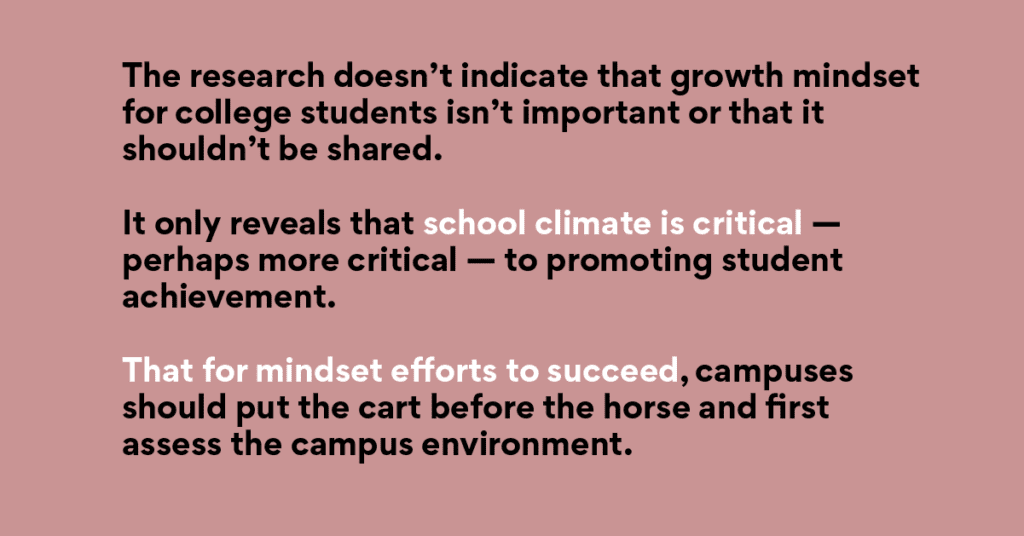The Key to Growth Mindset for College Students
Psychologist Carol Dweck has led research surrounding mindset theory. She coined the term “growth mindset” — the idea that ability is malleable that when students believe they can learn more, they put in more effort and achieve greater outcomes. Her research has shown that when you change a person’s mindset from fixed to growth, it increases both motivation and achievement.
But recent research reveals that there’s a catch. Growth mindset for college students works, but it’s not enough for them to hear that they can gain intelligence. They need to hear it in the context of the right school environment.
Growth Mindset for College Students: What the Latest Research Says
Establishing a growth mindset for college students has been accepted as a way to help them reach their full potential and lead to better academic achievements. But new research indicates that it may not be as effective as previously thought.
A study published in Social Psychology of Education found “insufficient evidence” to fully support the growth mindset for college students. While undergraduate students in remedial math classes who were taught the growth mindset saw a small increase in the likelihood that they would pass the course, there was no correlation between growth mindset and retention—meaning they were just as likely to drop out. A similar study echoed these results. While remedial math students did have slightly higher test scores when they were taught growth mindset, the results were not statistically significant.
Is it just math? No. Yet another recent study took a similar approach with English faculty and students at a community college. Just like the previous two examples, there were slight improvements—but nothing statistically significant.
A revealing new study expanded its evaluation of growth mindset for college students. Randomly assigned college students at a university with a diverse student population received a mindset message or a message endorsing study skills. There was no difference between the groups when it came to course grade, term GPA, term credit hours earned, or retention to subsequent terms.
Why didn’t the growth mindset messaging work in these instances? This study may have the answer. Thousands of students across the U.S. participated in a growth mindset intervention. And it worked… sometimes. The study found that for mindset approaches to be successful, they must be reinforced by a supportive environment.
Beyond the Individual
Even Carol Dweck, the leader who established the “growth mindset” term, has acknowledged that it’s not just about student effort. In her commentary published in Education Week, she said that, “Certainly, effort is key for students’ achievement, but it’s not the only thing. Students need to try new strategies and seek input from others when they’re stuck.”
Seeking input from others requires relationships and trust: attributes of a supportive learning environment.
We know that having a sense of belonging is associated with academic achievement and retention, so it’s not surprising that school climate would come into play here. The research doesn’t indicate that growth mindset for college students isn’t important or that it shouldn’t be shared. It only reveals that school climate is critical — perhaps more critical — to promoting student achievement. That for mindset efforts to succeed, campuses should put the cart before the horse and first assess the campus environment.

Creating a Supportive Campus Environment
Creating a positive learning environment where students feel seen and supported is important, and there’s an increased demand to make a paradigm shift from ensuring students are “college-ready” to making colleges more “student-ready.”
Every campus is different and faces unique challenges. Higher education institutions who work to understand the challenges their students face, and address them, can best support their students and foster a positive campus climate.
Some attributes and efforts that can be associated with a positive campus environment include:
- Celebrating academic success and curiosity
- Enhancing cultural confidence and cultural consciousness
- Improving campus safety through prevention efforts
- Building connections to promote a strong sense of community
- Giving students access to resources that support their health and wellbeing
- Supporting students through campus resources that reflect their needs
These are campus-wide efforts. Holistic approaches — like the stepped care model for student mental health — can be the most effective. When it comes to something as large and somewhat abstract as the campus environment, campus culture, or campus climate, it’s not a one-off project. It’s a combination of coordinating efforts that look at the larger picture.
Kognito Prevention Simulations: One Piece of the Puzzle
Over 400 campuses nationwide — ranging across geographies, enrollment, and funding resources — are currently using Kognito simulations as part of their efforts to create a supportive campus environment. Because our prevention simulations can be rolled out online, they have the power to reach the entire campus community and provide everyone with knowledge and skills that are shown to improve student mental health, retention, and academic performance. In particular, our At-Risk Mental Health for Students simulation has a focus on growth mindset and resiliency.
Explore how Kognito’s higher education simulations can promote efforts to improve your campus environment at Kognito.com.
Explore more articles from the Kognito blog: